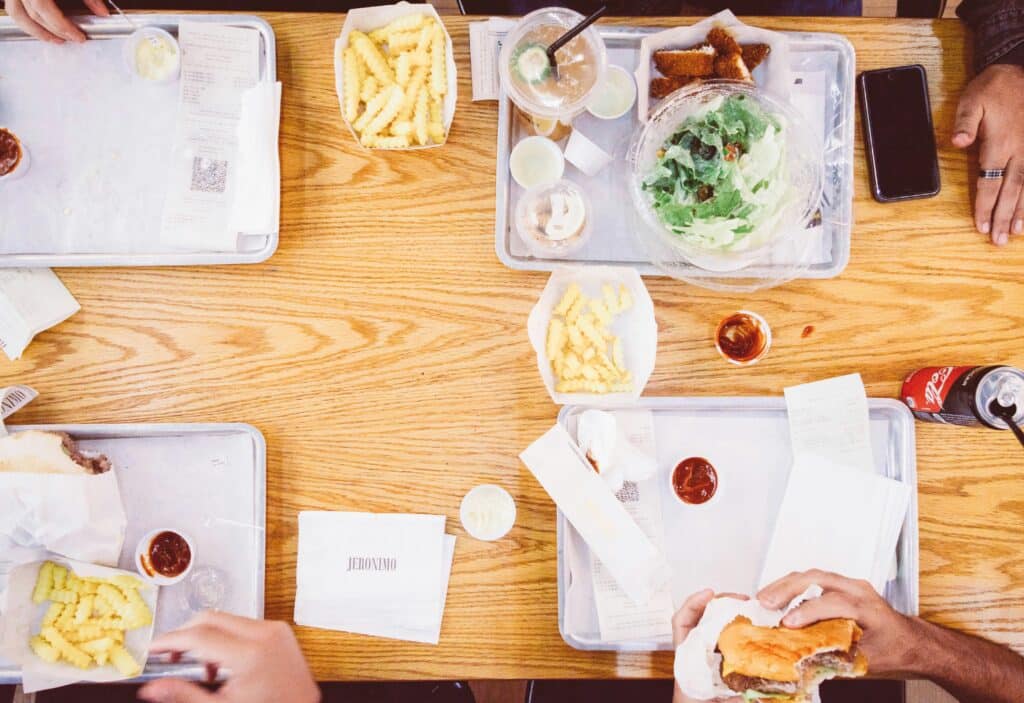Section 1: Introduction – A Story of Lunch Trays
It’s lunchtime, and you hear the bell ring. You walk into the cafeteria, grab a tray, and see pizza, fries, and milk waiting for you. Now, imagine you were in Japan, where students eat miso soup, rice, and grilled fish, or in France, where they might serve fresh bread, cheese, and vegetables. School lunches can look very different depending on where you live.
School lunches are not just about filling stomachs—they show us culture, health choices, and what adults think is important for kids to eat. In the United States, for example, over 29.6 million students take part in the National School Lunch Program every day (USDA, 2023). Around the world, the World Food Programme estimates that over 368 million children are given school lunches daily (WFP, 2023). That means more children eat a school lunch every day than the population of the entire United States.
Looking at school lunches is like looking at a map of how countries care for their students. Some focus on fresh, local food. Others make sure every child gets enough calories, even if it means serving more basic meals. The differences tell us about nutrition, health, and fairness.
In this article, we’ll explore 15 different school lunches from around the world. We’ll use tables, facts, and real examples to see how each country feeds its students. Platforms like Scholarly Sphere share blogs and articles that help students learn about education, culture, and school life, making it easier to see how we’re all connected through something as simple as lunch.
School Lunches Around the World

School lunches are served in every corner of the globe, but what’s on the tray depends on culture, money, and tradition. Some schools serve fresh vegetables and fish every day, while others provide simple meals to fight hunger. Looking at different countries helps us understand not only what students eat but also what societies value.
🌍 Table of 20 School Lunches
| Country | Typical School Lunch | Extra Notes |
|---|---|---|
| United States | Pizza, chicken nuggets, fries, milk, fruit | The National School Lunch Program feeds 29.6 million students daily(USDA, 2023). Meals vary, but processed food is common. |
| Japan | Rice, fish, miso soup, vegetables, milk | Students eat together in classrooms. Lunch is seen as part of education, and kids help serve. |
| France | Fresh bread, cheese, salad, yogurt, fruit | Lunches last around 30–40 minutes, giving students time to eat multiple courses. |
| South Korea | Rice, kimchi, soup, meat or fish, fruit | Highly nutritious, with an emphasis on vegetables and fermented food for digestion. |
| Brazil | Rice, beans, meat, salad, fruit | The National School Feeding Program reaches 40 million kids, focusing on local farmers (FAO, 2021). |
| Italy | Pasta, vegetables, bread, fruit, water | Fresh, seasonal foods are prioritized; processed snacks are discouraged. |
| United Kingdom | Fish and chips, curry, sandwiches, fruit | Meals are influenced by both British classics and multicultural dishes. |
| India | Rice or roti, lentils, vegetables, sometimes eggs | The Midday Meal Scheme serves 120 million children daily, the largest in the world (India Ministry of Education, 2022). |
| Finland | Soup or stew, rye bread, salad, milk | Since 1948, all students get free hot lunches; meals balance protein, carbs, and veggies. |
| China | Rice or noodles, vegetables, tofu, meat, soup | Portions are large to provide energy, and menus shift by region. |
| Mexico | Tacos, rice, beans, fruit, water | Nutrition programs aim to reduce obesity by including fresh fruit instead of soda. |
| Kenya | Ugali (maize porridge), beans, greens | For many children, this is the only meal of the day, provided through aid programs. |
| Turkey | Lentil soup, rice, stuffed vegetables, yogurt | Meals often reflect traditional Turkish cooking, with fresh herbs and spices. |
| Sweden | Meatballs, potatoes, salad, crispbread, milk | Free for all students; menus are designed by nutritionists. |
| Ghana | Rice, beans, stew, or porridge | The Ghana School Feeding Programme reaches 2.6 million students (GSFP, 2023). |
| Thailand | Rice, stir-fried vegetables, chicken, soup | Meals are colorful, with plenty of herbs and spices, and often fruit for dessert. |
| Ethiopia | Injera (flatbread), lentils, vegetables | Simple but filling; school meals are essential for fighting hunger. |
| Australia | Meat pies, sandwiches, fruit, milk | Not all schools serve hot meals; many students bring lunch from home. |
| Canada | Pasta, sandwiches, milk, fruit | Some provinces offer free lunch programs, but many rely on packed lunches from home. |
| Argentina | Beef, pasta, bread, fruit | Meals often include beef, reflecting Argentina’s cattle-farming culture. |
🔹 What We Learn from 20 Countries

- Health & Balance: Countries like Japan, Finland, and South Korea focus on balanced meals with lots of vegetables and fresh cooking.
- Cultural Identity: Lunch in France, Italy, and Mexico reflects local traditions and eating habits.
- Scale & Reach: Programs in India, Brazil, and the U.S. serve tens of millions daily, showing how big government school lunch systems can be.
- Inequality: In Kenya, Ghana, and Ethiopia, school lunch is often the most important meal of the day, highlighting how food security shapes education.
- Student Role: In Japan, students serve lunch and clean up together, making meals part of learning responsibility.
School lunches may look very different, but they all share one goal: to give students the energy and health they need to succeed in school.
Why School Lunches Matter

Looking at school lunches from 20 countries shows that food is more than just nutrition. It reflects culture, health, and fairness, and it can even influence how students feel about school. Some nations make sure every meal is balanced with vegetables, protein, and grains, while others focus mainly on giving children enough calories to stay full and energized. Either way, what students eat at school can affect their ability to concentrate, learn, and grow.
School lunches also teach students about responsibility and community. In Japan, children serve each other, set the tables, and clean up afterward, learning teamwork and respect. In countries like Ghana or Kenya, school lunch programs can be life-changing because they provide the only meal a student might eat all day. Meals like these show how school lunches are connected to health, education, and equality.
Nutrition is closely tied to learning. Studies have shown that students with regular access to healthy meals have better attention spans, improved memory, and higher test scores. Countries that prioritize school lunches are not just feeding children—they are helping them reach their full potential. For example, Finland and South Korea design menus with nutritionists to make sure children get the right balance of vitamins and minerals every day.
Platforms like Scholarly Sphere help students explore topics like this, offering blogs and articles about learning, education, and school life. Understanding school lunches around the world encourages curiosity and global awareness. It also shows that simple things, like what’s on a lunch tray, can teach lessons about culture, fairness, and caring for others.
In the end, school lunches remind us that no matter where we live, students everywhere share the need for healthy food and energy to learn. They are a small part of the school day, but they tell a big story about the way the world cares for its children. So, what can we learn about ourselves and our communities just by looking at what’s on a student’s lunch tray?
Works Cited
FAO. School Meals: Brazil’s National School Feeding Program. Food and Agriculture Organization, 2021. https://www.fao.org/school-food/en
Ghana School Feeding Programme. About GSFP. Government of Ghana, 2023. https://gsfp.gov.gh/
India Ministry of Education. Midday Meal Scheme. Government of India, 2022. https://pmposhan.education.gov.in/
United Nations Children’s Fund (UNICEF). Nutrition: Improving Children’s Health. UNICEF, 2022. https://www.unicef.org/nutrition
United States Department of Agriculture (USDA). National School Lunch Program Facts. USDA, 2023. https://www.fns.usda.gov/nslp
World Food Programme (WFP). School Meals Around the World. WFP, 2023. https://www.wfp.org/school-meals


